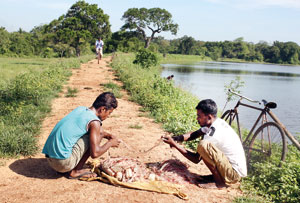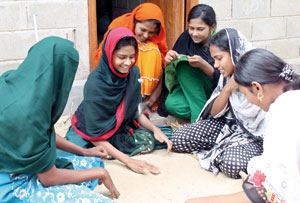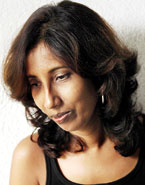‘Country without documentary filmmaking is like a home without a family album,’ says Anoma Rajakaruna writer, reputed photographer, award winning tele-filmmaker and leading documentary director.
The first director to undergo authoritative censorship in the miniscreen for the bold and brave themes and issues tackled, Anoma’s years of struggle for the freedom of expression ended up discovering the documentary filmmaker in her. Due to the lack of documentary understanding, this award winning filmmaker says that the country is losing the opportunity to record its audio-visual history.
 |
| Documentary ‘When water decides the way of life’ |
 |
| Documentary ‘Seeking Harmony...’ |
Started filmmaking as early as 17 years of age while being a student of Panadura Balika Maha Vidyalaya, Anoma’s struggle to express serious issues through the television medium was not welcomed mostly by the authorities. Battered by political censorship at a time ‘censor’ was not a word related to the television medium, one of Anoma’s early teleplays ‘Amma Kenek’ in 1987 which had to be screened at the President’s House was banned by the then President purely for political reasons.
“The teledrama was about the 1983 violence and it tells about a son who loved his Tamil mother but detested the Tamils. The authorities thought this was not in favour of the Presidential election it was going to contest. It was stopped directly on the President’s order,” said Anoma describing her difficult journey.
Began filmmaking with a stock of ‘Super-8’ reels which were put out by the company for a few bucks, Anoma managed to make three short films with it.
“I collected money for a long time and waited for the company to put out the ex-stock which had passed the expiry date,”.
Banning and blocking were not new words for Anoma’s journey of tele-film direction. Her very first direction in Rupavahini was in 1983, a tele-film ‘Sonduriya’ a story about war and a displaced woman who takes up a journey in search of her lost husband was not allowed to be broadcast. “There was no proper review board at that time and this was about war. It was also a time where people in Colombo were unaware about and its horrible experience,” says Anoma. However the tele-film was broadcast on ITN. Her next tele-film "Ingiyak Nisa..." (The Signal) based on Guy de Maupassant's short story in 1984 was played by leading stars Radha de Mel and Veena Jayakody, which was again blocked from broadcasting by the authorities.
“During this time I was hanging around, the British Council, Alliance Francaise and OCIC watching films and in order to expertise my knowledge I took up the OCIC cinema course organized by the Catholic National Commission for Social Communication. I was trained by veteran cinematographer Andrew Jayamanne,” says Anoma. Subsequently at the film festival held to celebrate the 10th anniversary of the OCIC, Anoma’s tele-film ‘Amma Kenek’ won the Best Teledrama of the year award in 1988.
Anoma’s tele-film ‘Vilangu’ a story about a single mother based on a true incident in Sri Lanka was done for the Women’s Day in 1989. This tele-film narrated about a mother who went to courts against her son was banned again.
“By this time I had to give serious thought of my future. Whether to go on like this or to search for some alternative medium of expression. It was at this stage that I started to do documentaries titled ‘Mask Makers’ and ‘Bit of Paradise’,” narrated Anoma on her entry to documentary making.
After five years, her tele-film ‘Vilangu’ was passed by a five-member board and was telecast with rave reviews by the critics. “Writer and scholar Reggie Siriwardena who was impressed by the tele-film wrote one of the early reviews and he invited me to do a documentary on ‘War’ for the International Centre for Ethnic Studies (ICES). I was given the second of three parts of the documentary series ‘Wounds of War-Bonds of Peace-Living Together’ done by ICES and I highlighted on places where people of different races were living in peace and harmony. I focused on Thalawakele, Doowa in Negombo and ‘60 Watta’ in Colombo where Tamil and Sinhalese were living in harmony and it was selected for the first South Asian Documentary Film Festival,”.
Having participated in the festival where the documentary reached the finals Anoma’s horizon was widened and this encouraged her to take up a career as a documentary filmmaker.
Having long suffered, firstly being in the infancy of my career and then as a woman in an industry dominated by men, Anoma realised that documentary films would give her more independence to express herself which made the turning point in her ife.
“Our TV is not for serious and sensitive issues. It cater s to only family sagas and melodramas and a lot of TV space is taken over by realty shows and mega dramas. While television is allocating time for fantasy there is no space for the reality which is depicted in documentary. I realised not to depend on the local television stations by making documentaries,” she said with a sense of satisfaction.
“I was glad that there was no political interference or censorship for documentaries and there was also a market outside,” she added.
With the greed for money and market, the local television stations or the authorities don’t realise the importance of the culture in documentaries. If there is any space for documentary it is only for environmental wonders or travelogues and not dedicated to environmental problems. “Documentary industry in other countries also survives not because of the availability of a market but because of the dedication of the TV stations and the government,” Anoma complained.
As a result of this, we are losing a lot of audio-video history and its important issues, Anoma reiterated.
To Anoma who always thought, dreamt and worked ahead of her age, struggled and fought for the principles she believed, documentary filmmaking provided the medium for her expression.
“While there is an aesthetic satisfaction, documentaries have given me a platform for activism,” says Anoma with content.
Details of Anoma’s Documentaries
 |
| Anoma Rajakaruna |
Some of the landmark documentaries in Anoma’s journey were ‘Through a Glass Darkly…- documentary on sexual harassment-1995, ‘Violence Against Women’- 1996, ‘Nurturing Nature’- documentary on Women in the Central Hills-1998, ‘Face to Face’- a ocumentary on human-elephant conflict-1998, ‘Touching the Untouchables’- a documentary on garbage recycling and disabilities-1998, ‘Beyond the Obvious’- a documentary on National Women’s Charter in Sri Lanka-1999, ‘Shakthi Sanhitha’- 10 episode documentary series on Alternative Energy-1999, ‘Yet Another Five…’- a documentary on five rape victims-2000, ‘Butterfly will Always Fly…’- a documentary on People with disabilities-2003, ‘The Other Women’- a documentary on Women and Armed Conflict in Sri Lanka, 2004 and ‘Our Story-Women who loved women in Sri Lanka”. Anoma’s latest documentaries completed this year ‘When Water decides the way of life’- Indigenous knowledge on water and environment in relation to climate change- a project by PLAN Sri Lanka and ‘Seeking Harmony’ , a research on displaced Muslims and people in Puttlam in a post war situation produced by FLICT and GIZ are to be released soon.
|




